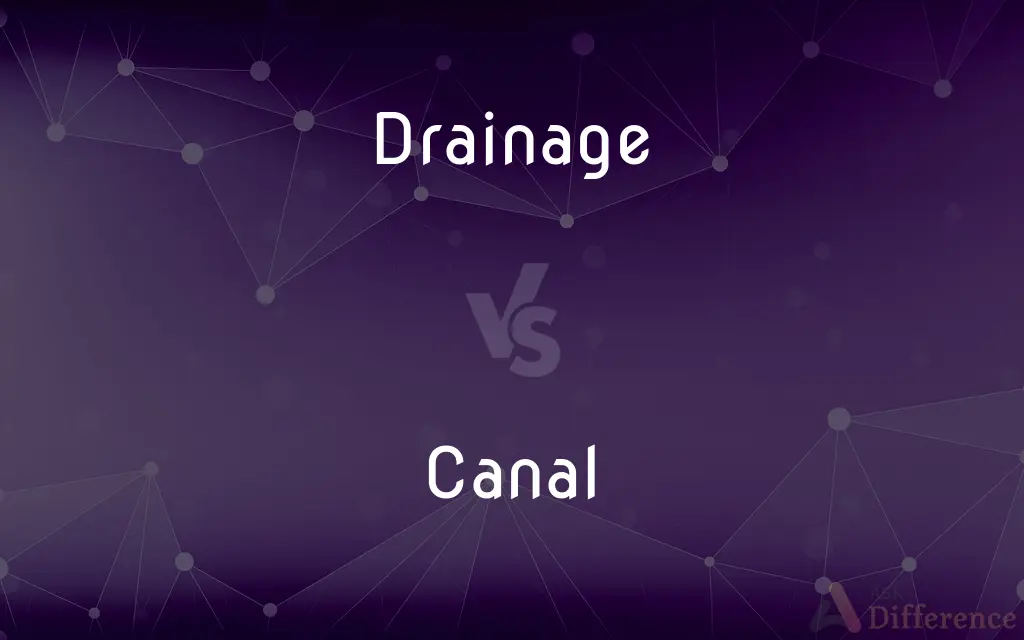Drainage vs. Canal — What's the Difference?
Edited by Tayyaba Rehman — By Fiza Rafique — Updated on February 26, 2024
Drainage systems remove excess water from land, enhancing its usability and preventing waterlogging, while canals are man-made waterways designed for transportation, irrigation, or connecting bodies of water.

Difference Between Drainage and Canal
Table of Contents
ADVERTISEMENT
Key Differences
Drainage systems, including ditches and pipes, are crucial for managing water levels in agricultural, urban, and industrial areas. They help prevent flooding and waterlogging, thereby protecting crops, infrastructure, and property. Canals, on the other hand, are engineered to facilitate water navigation, irrigate lands, or move water to areas where it's needed, playing a significant role in commerce, agriculture, and urban development.
Drainage systems are primarily about water removal, while canals focus on water distribution and transportation. Drainage improves soil health and reduces the risk of erosion and property damage, while canals can enhance economic growth by enabling the transport of goods and people, as well as by supporting agriculture through irrigation.
The construction and maintenance of drainage systems and canals require different considerations. Drainage systems must ensure efficient water flow away from critical areas, often relying on gravity, whereas canals may require extensive excavation, lining, and sometimes pumping stations to maintain water levels and flow for navigation and irrigation.
Environmental impacts also differ between the two. Properly designed drainage systems can mitigate flooding risks and protect ecosystems by controlling soil moisture levels. Conversely, canals can significantly alter landscapes and ecosystems, potentially disrupting local habitats but also providing new aquatic environments.
Both drainage systems and canals are vital to human activity, yet they serve distinct purposes. Drainage systems safeguard against water-related issues on land, while canals create pathways for water movement and use, each contributing to sustainable land and water management in their unique ways.
ADVERTISEMENT
Comparison Chart
Primary Purpose
Remove excess water from land
Transport water or vessels
Key Function
Prevent waterlogging and flooding
Navigation, irrigation, connecting waters
Construction Focus
Ensuring efficient water flow away
Excavation, lining, sometimes pumping
Environmental Impact
Mitigates flooding, protects ecosystems
Can alter landscapes, disrupt or create habitats
Utilization
Agriculture, urban planning
Commerce, agriculture, urban development
Compare with Definitions
Drainage
Vital for agricultural productivity and health.
Proper drainage boosts crop yields by preventing waterlogging.
Canal
Man-made waterways for transportation or irrigation.
The canal connected the two rivers, opening up new trade routes.
Drainage
A system to remove surplus water from land.
The new drainage system prevented the annual flooding of the farmland.
Canal
Often involves locks to manage water levels.
The canal's lock system allows ships to navigate steep elevations.
Drainage
Aims to control soil moisture levels.
Field drainage was improved to enhance soil conditions for planting.
Canal
Plays a role in urban development and planning.
The new canal project will revitalize the downtown waterfront.
Drainage
Ensures water flows away to protect infrastructure.
Drainage ditches were cleared to safeguard the road from stormwater.
Canal
Can link isolated water bodies for various purposes.
The irrigation canal brings much-needed water to the arid region.
Drainage
Can include natural and man-made elements.
The city's drainage plan integrates existing creeks with underground pipes.
Canal
Facilitates the movement of goods and people.
Barges on the canal transport goods more efficiently than trucks.
Drainage
Drainage is the natural or artificial removal of a surface's water and sub-surface water from an area with excess of water. The internal drainage of most agricultural soils is good enough to prevent severe waterlogging (anaerobic conditions that harm root growth), but many soils need artificial drainage to improve production or to manage water supplies.
Canal
Canals are waterway channels, or artificial waterways, for water conveyance, or for servicing water transport vehicles. They carry free surface flow under atmospheric pressure, and can be thought of as artificial rivers.
Drainage
The action or a method of draining.
Canal
An artificial waterway constructed to allow the passage of boats or ships inland or to convey water for irrigation
The Oxford Canal
They travelled on by canal
Drainage
A natural or artificial means for the removal of fluids from a given area by its draining away.
Canal
An artificial waterway or artificially improved river used for travel, shipping, or irrigation.
Drainage
A draining; a gradual flowing off of any liquid; also, that which flows out of a drain.
Canal
An artificial channel filled with water and designed for navigation, or for irrigating land, etc.
Drainage
The mode in which the waters of a country pass off by its streams and rivers.
Canal
A tube or duct; as, the alimentary canal; the semicircular canals of the ear.
Drainage
The system of drains and their operation, by which superfluous water is removed from towns, railway beds, mines, and other works.
Canal
A long and relatively narrow arm of the sea, approximately uniform in width; - used chiefly in proper names; as, Portland Canal; Lynn Canal.
Drainage
The act, process, or means of drawing off the pus or fluids from a wound, abscess, etc.
Canal
Long and narrow strip of water made for boats or for irrigation
Common Curiosities
How does a drainage system affect urban areas?
It reduces flooding risk, protects infrastructure, and can enhance living conditions by managing water effectively.
What is the main purpose of a drainage system?
To remove excess water from land, preventing waterlogging and flooding.
Can drainage systems and canals coexist in the same area?
Yes, they often complement each other, with drainage systems managing water levels and canals facilitating water transport or irrigation.
What role do pumps play in drainage and canal systems?
In drainage, pumps help remove water from low-lying areas; in canals, they maintain water levels for navigation and irrigation.
Are all drainage systems underground?
No, some are open ditches or channels, although many urban systems use underground pipes.
How do these systems impact property values?
Proper drainage can protect and enhance property values, while canals may increase values by providing water access or views.
What are the environmental considerations when constructing a canal?
Impact on local ecosystems, water flow alterations, and potential habitat disruption or creation.
How do canals benefit agriculture?
By providing irrigation, ensuring water reaches farmland that would otherwise be too dry.
What makes canals significant for transportation?
They allow for the efficient, cost-effective movement of goods and people, often connecting regions that lack direct road or rail routes.
Can canals be natural?
While most are man-made, some natural waterways are modified and used as canals.
What technological advancements are influencing drainage and canal systems?
Innovations include more efficient pumping systems, sustainable water management practices, and advanced materials for construction and maintenance.
How does climate change affect drainage and canal systems?
It challenges both, requiring adaptive measures to handle increased rainfall, drought conditions, and sea-level rise.
Can the construction of a canal lead to water scarcity in some areas?
Yes, if it diverts water away from areas that depend on the original water source, leading to potential conflicts over water rights.
Do both systems require regular monitoring?
Absolutely, to ensure they function effectively and to prevent or address issues promptly.
Is maintenance different for drainage systems versus canals?
Yes, drainage systems often require clearing obstructions and repairing leaks, while canals need dredging and lock maintenance.
Share Your Discovery

Previous Comparison
Bindle vs. Sack
Next Comparison
Tinsel vs. TensileAuthor Spotlight
Written by
Fiza RafiqueFiza Rafique is a skilled content writer at AskDifference.com, where she meticulously refines and enhances written pieces. Drawing from her vast editorial expertise, Fiza ensures clarity, accuracy, and precision in every article. Passionate about language, she continually seeks to elevate the quality of content for readers worldwide.
Edited by
Tayyaba RehmanTayyaba Rehman is a distinguished writer, currently serving as a primary contributor to askdifference.com. As a researcher in semantics and etymology, Tayyaba's passion for the complexity of languages and their distinctions has found a perfect home on the platform. Tayyaba delves into the intricacies of language, distinguishing between commonly confused words and phrases, thereby providing clarity for readers worldwide.















































